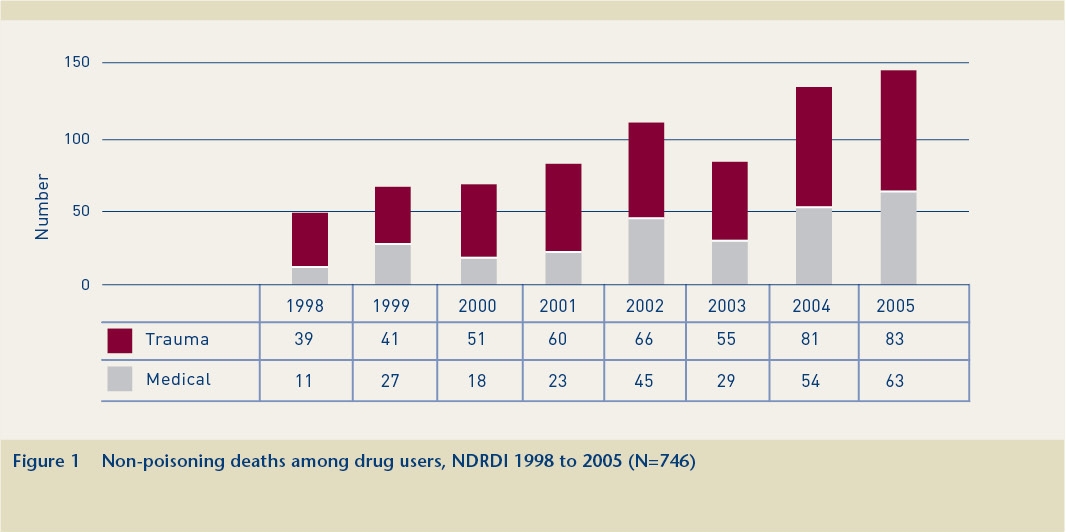The Health Research Board (HRB) published the first national report on non-poisoning deaths among drug users in Ireland in November 2009.1 The data presented describe trends in non-poisoning deaths (deaths due to traumatic or medical causes) among drug users between 1998 and 2005. This paper is a companion to HRB Trends Series 4, which analysed trends in deaths by poisoning (directly drug-related deaths).2 The data used for the analysis were obtained from the National Drug-Related Deaths Index (NDRDI) maintained by the Alcohol and Drug Research Unit of the HRB.
Overall, the annual number of drug-related deaths and deaths among drug users recorded in the NDRDI increased in the years 1998–2005 The total number of deaths in the eight-year period was 2,441, of which 885 (36.3%) were non-poisonings.
Of the non-poisoning deaths with a known cause (n=746), over half (476, 63.8%) were the result of trauma. Figure 1 shows that the annual number of these deaths more than doubled over the reporting period. The annual number of deaths from medical causes increased by almost 500% over the same period.

Half of the deaths due to trauma were of young men aged between 20 and 29 years. The most common causes of death due to trauma were hanging (174, 36.5%) and road traffic collisions (95, 20.0%). Almost half of those involved in road traffic collisions were driving a vehicle at the time of the accident.
Alcohol was present in nearly three-fifths (241, 58.5%) of the deaths due to trauma that had a positive toxicology. Cannabis was the illicit drug most commonly found in the toxicology results of deaths due to trauma (227, 55.1%).
When the traumatic deaths that had a positive toxicology were analysed by type of death, cannabis (40, 67.8%), opiates (24, 40.7%) and cocaine (18, 30.5%) were found in the greatest proportions in deaths due to violence (shooting, stabbing or assault). MDMA (ecstasy) (26, 28.6%) was found in the greatest proportion in deaths due to road traffic collisions.
Over three-quarters of the deaths due to medical causes were of males, and the majority were aged between 30 and 44 years. The most common medical causes of death were cardiac events (67, 24.8%), followed by respiratory infections (48, 17.8%) and liver disease (31, 11.5%).
The majority (180, 66.7%) of drug users who died of medical causes had a history of opiate use. Three-fifths (19, 61.3%) of those who died of liver disease had a history of alcohol dependency. The highest numbers of cocaine users (n=12) and cannabis users (n=24) were among those who died from a cardiac event.
Of the total number of deaths (including poisoning and non-poisoning deaths) recorded by the NDRDI in the period 1998–2005, 192 (7.9%) cases had a documented history of a blood-borne viral infection. The annual number of these cases increased from nine in 1998 to 41 in 2005.
The number of drug users who have acquired a blood-borne viral infection highlights the need for continued and expanded harm reduction programmes, including treatment for problem alcohol use, to reduce the risk of infection and prevent the long-term health consequences of liver damage.
The number of drug users who died from hanging or from drowning supports the argument that substance misuse is related to suicide. There is a need for increased awareness and education around this issue, especially for those with a dual diagnosis of mental health and substance misuse problems who are already in treatment, and those who present at emergency rooms with non-fatal drug- or alcohol-related injuries.
The number of drug users who were driving at the time of their death and had a positive toxicology is further evidence of the need for more reliable statistics on drink/drug driving. There is a need for expansion of the forensic analysis programme to ascertain the true incidence of driving while under the influence of drugs and/or alcohol. Unfortunately, there is currently no reliable system of road-side testing for the presence of drugs in the body.
The correlation of toxicology and drug-use history with the type of death recorded supports the argument that drug use is contributing to the premature death of drug users in Ireland. More effective measures are required to educate drug users about the health consequences of drug use, particularly the cardio-toxic effects of cocaine.
The continuing upward trend in drug-related deaths revealed in this paper and in its predecessor, Trends Series 4, reflects the increasing numbers in the population who are consuming drugs and taking risks and who have acquired infections or developed medical conditions associated with drug use.
1. Lynn E, Lyons S, Walsh S and Long J (2009) Trends in deaths among drug users in Ireland from traumatic and medical causes, 1998 to 2005. HRB Trends Series 8. Dublin: HRB.
2. Lyons S, Lynn E, Walsh S and Long J (2008) Trends in drug-related deaths and deaths among drug users in Ireland, 1998 to 2005. HRB Trends Series 4. Dublin: HRB.
